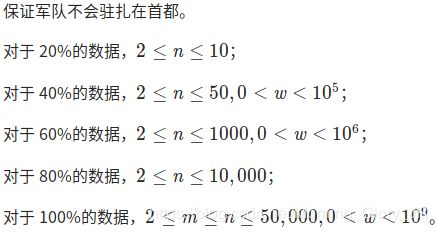也许更好的阅读体验
\(\mathcal{Description}\)
原题链接

一句话题意
一个人可以堵住一个子树,不能一次堵住整棵树,求堵住每个通往叶子节点的路径,走的最远的那个人走的路程最少是多少,若不能堵住输出\(-1\)

\(\mathcal{Solution}\)
看了下其他题解,都说很毒瘤
最开始我也认为很毒瘤
就是在决定一个点是否要跨过根这个地方比较麻烦
但是在码的途中,突然想到一个无脑的方法
于是写起来就很愉快了
最...最..,显然二分路程是多少
再继续想之前,先看一下我们\(check\)函数要求在什么复杂度决定
\(n\leq 50000\),可以\(nlog^2n\)解决,也就是说\(check\)的复杂度只要小于\(nlogn\)即可
一个人在二分到的路程内,尽量往上走是最优的
若一个人可以到达根节点,那么就要考虑其跨过这个根节点去堵其它子树
显然,若跨过根节点,那么走到根节点下面的那个节点就可以了
对于一个可以跨过根节点的人,他可能不要跨过根节点,也可能要跨过根节点
也可能一个子树里的人跨过根节点去堵其他子树,另外的一个子树的人跨过根节点来堵他的子树,这是因为原来这个子树的人比较靠近根节点,跨过根节点后走的较远,而他所在子树与根节点的路径又比较短
想想好像有点麻烦,想到这顿时觉得这题很毒瘤
但其实,我们不用想那么多
我们把所有能跨过根节点的人都走到根节点
将其还允许走的路程全部记下来
把所有需要人去堵的子树找出来,记下其与根节点的距离
显然,能走得最远的人去堵距离根节点最远的子树是最优的
也就是说要从大到小排序,这个过程我们用一个大根堆维护即可
对于一个到子树的距离,我们记下其子树的编号,对于每棵子树,我们记下其内可以跨过根节点的人中,还允许走的路程最少的路程是多少
再考虑一个人可能不要跨过根节点,我们在弹大根堆时,若发现这棵子树可以用比当前允许走的路程最大的人更小的人替代,那么那个人就不需要跨过根节点了
由于那个人仍然在大根堆内,我们把其记在一个队列里,表示有哪些路程被提前用了
这样就是最优的
仍有不懂请看代码,我觉得还是很无脑的,毕竟什么特殊的操作都没有,代码应该一下就看懂了
\(\mathcal{Code}\)
/*******************************
Author:Morning_Glory
LANG:C++
Created Time:2019年10月22日 星期二 20时50分59秒
*******************************/
#include
#include
#include
#define ll long long
#define inf 12345678987654
#define mp make_pair
using namespace std;
const int maxn = 500005;
const int maxm = 1000006;
const int lim = 20;
//{{{cin
struct IO{
template
IO & operator>>(T&res){
res=0;
bool flag=false;
char ch;
while((ch=getchar())>'9'||ch<'0') flag|=ch=='-';
while(ch>='0'&&ch<='9') res=(res<<1)+(res<<3)+(ch^'0'),ch=getchar();
if (flag) res=~res+1;
return *this;
}
}cin;
//}}}
int n,m,cnt,u,v,val,num;
int head[maxn],nxt[maxm],to[maxm],w[maxm],hav[maxn],dep[maxn],lg[maxn]={-1};
int fa[maxn][lim];
ll l,r,mid;
ll d[maxn],f[maxn];
bool vis[maxn];
priority_queue qc,qf;
priority_queue < pair >qn;
//{{{add
void add (int u,int v,int val)
{
nxt[++cnt]=head[u],head[u]=cnt,to[cnt]=v,w[cnt]=val;
}
//}}}
//{{{dis
ll dis (int x,int y)
{
return d[x]>d[y]?d[x]-d[y]:d[y]-d[x];
}
//}}}
//{{{dfs
void dfs (int x)
{
r=max(r,d[x]);
for (int i=1;i<=lg[dep[x]];++i) fa[x][i]=fa[fa[x][i-1]][i-1];
for (int e=head[x];e;e=nxt[e])
if (to[e]!=fa[x][0]){
fa[to[e]][0]=x,dep[to[e]]=dep[x]+1;
d[to[e]]=d[x]+w[e];
dfs(to[e]);
}
}
//}}}
//{{{move
void move (int x,int nm)
{
ll t=mid;
for (int i=lg[dep[x]];~i;--i){
ll ds=dis(fa[x][i],x);
if (fa[x][i]>1&&t>=ds) t-=ds,x=fa[x][i];
}
if (t>dis(1,x)){
ll ds=t-dis(1,x);
f[x]=min(f[x],ds);
while (nm--) qc.push(ds);
}
else vis[x]=true;
}
//}}}
//{{{chk
bool chk (int x)
{
if (vis[x]) return false;
bool flag=true;
for (int e=head[x];e;e=nxt[e])
if (to[e]!=fa[x][0]){
flag=false;
if (chk(to[e])) return true;
}
return flag;
}
//}}}
//{{{check
bool check ()
{
while (!qc.empty()) qc.pop();
while (!qn.empty()) qn.pop();
while (!qf.empty()) qf.pop();
for (int i=1;i<=n;++i) vis[i]=0,f[i]=inf;
for (int i=1;i<=n;++i)
if (hav[i]) move(i,hav[i]);
for (int e=head[1];e;e=nxt[e])
if (chk(to[e])) qn.push(mp(w[e],to[e]));
while (!qn.empty()){
val=qn.top().first,v=qn.top().second,qn.pop();
while (!qf.empty()&&qf.top()==qc.top()) qf.pop(),qc.pop();
if (qc.empty()) return false;
if (qc.top()qc.top()) return false;
qf.push(f[v]);
}
else if (f[v]<=qc.top()) qf.push(f[v]);
else qc.pop();
}
return true;
}
//}}}
int main()
{
cin>>n;
for (int i=1;i<=n;++i) lg[i]=lg[i>>1]+1;
for (int i=2;i<=n;++i){
cin>>u>>v>>val;
if (u==1||v==1) ++num;
add(u,v,val),add(v,u,val);
}
cin>>m;
if (m>u,++hav[u];
dfs(1);
r<<=1;
while (l 如有哪里讲得不是很明白或是有错误,欢迎指正